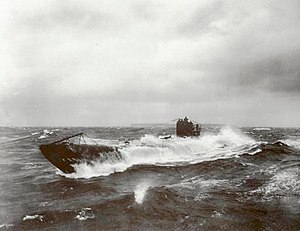SM UB-144
 UB-148 at sea, a U-boat similar to UB-144.
| |
| History | |
|---|---|
| Name | UB-144 |
| Ordered | 27 June 1917[2] |
| Builder | AG Weser, Bremen |
| Cost | 4,301,000 German Papiermark |
| Yard number | 310 |
| Launched | 5 October 1918[1] |
| Fate | Surrendered 27 March 1919; sold for scrap 22 July 1920; hulk dumped in Medway estuary 1922 |
| General characteristics [1] | |
| Class and type | German Type UB III submarine |
| Displacement |
|
| Length | 55.85 m (183 ft 3 in) (o/a) |
| Beam | 5.80 m (19 ft) |
| Draught | 3.75 m (12 ft 4 in) |
| Propulsion |
|
| Speed |
|
| Range |
|
| Test depth | 50 m (160 ft) |
| Complement | 3 officers, 31 men[1] |
| Armament |
|
| Service record | |
| Part of: | German Imperial Navy |
UB-144 was a German Type UB III submarine or U-boat built for the German Imperial Navy (German: Kaiserliche Marine) during World War I. Incomplete at the end of the war, she was surrendered to the Allies at Harwich on 27 March 1919, and then taken to Chatham Dockyard as a potential subject for experimental work, but was never so-employed.[3] She was sold to M. Lynch & Sons on 22 July 1920 for £2,000, and towed to Rochester, Kent. After being stripped of any reusable material, the hulk was dumped in shallow water in the Medway estuary, along with those of UB-145 and UB-150. The remains of all three - partly broken up in-situ during 1939–45, with one significantly better preserved than the other two - remain visible, but it is unclear which wreck is which.[4]
Construction[]
She was built by Friedrich Krupp Germaniawerft of Kiel and following just under a year of construction, launched at Kiel on 5 October 1918. UB-144 was to have carried 10 torpedoes and be armed with a 10.5 cm (4.13 in) deck gun. UB-144 would have carried a crew of up to 3 officers and 31 men and have a cruising range of 7,280 nautical miles (13,480 km; 8,380 mi). UB-144 had a displacement of 523 t (515 long tons) while surfaced and 653 t (643 long tons) when submerged. Her engines would have enabled her to travel at 13.5 knots (25.0 km/h; 15.5 mph) when surfaced and 7.5 knots (13.9 km/h; 8.6 mph) when submerged.
References[]
Notes[]
Citations[]
- ^ Jump up to: a b c Gröner 1991, pp. 25–30.
- ^ Rössler 1979, p. 56.
- ^ Dodson, Aidan; Cant, Serena (2020). Spoils of War: the fate of enemy fleets after the two World Wars. Barnsley: Seaforth. pp. 18, 51, 130. ISBN 978-1-5267-4198-1.
- ^ Dodson and Cant, pages=100–101
Bibliography[]
- Bendert, Harald (2000). Die UB-Boote der Kaiserlichen Marine, 1914-1918. Einsätze, Erfolge, Schicksal (in German). Hamburg: Verlag E.S. Mittler & Sohn GmbH. ISBN 3-8132-0713-7.
- Gröner, Erich; Jung, Dieter; Maass, Martin (1991). U-boats and Mine Warfare Vessels. German Warships 1815–1945. 2. Translated by Thomas, Keith; Magowan, Rachel. London: Conway Maritime Press. ISBN 0-85177-593-4.
- Rössler, Eberhard (1979). U-Bootbau bis Ende des 1. Weltkrieges, Konstruktionen für das Ausland und die Jahre 1935 - 1945. Die deutschen U-Boote und ihre Werften (in German). I. Munich: Bernard & Graefe. ISBN 3-7637-5213-7.
- German Type UB III submarines
- World War I submarines of Germany
- 1918 ships
- Ships built in Bremen (state)
